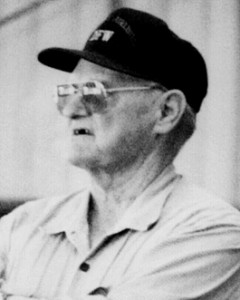
Arlington cowboys, the subject of my previous post, reminded me of a story that Billy Bush told me about Bob Burton.
Bush and his brothers, Stanley and Jimmie, were early-day cutting champions and the brothers-in-law of Matlock Rose, for whom they all worked back in the 1940s and 1950s.
As a teenager, Billy Bush spent his summers in Lake Dallas with his sister Freddie and Matlock. One Sunday afternoon in 1946, Rose and Bush drove to Arlington to see if there were any job openings at the famous 3D Ranch.
At the time, Rose was breaking horses for $15 a head and making ends meet with a job at the Fort Worth Stock Yards.
“He’d get up at two or three in the morning and work at counting and mouthing sheep at the Stock Yards,” Bush told me. “Then he’d get home at noon and ride horses until way past dark; then he’d sleep three or four hours and get up and go back down to the Stock Yards.
“I never will forget, when we drove up to the 3D, Bob Burton, the foreman, was mowing his lawn with an old push mower and with his spurs on.”
Burton told Rose that as a married hand he would receive $90 a month and be furnished with a house and a milk cow.
“Matlock was breaking horses and they were pretty wild. But at the same time, he was supplementing his income by riding bareback horses in the rodeo and it kind of helped,” recounted Bush, who made $60 a month cleaning and bedding the 3D Ranch’s stalls.
Coincidentally, I’ve been reading the Autobiography of Mark Twain Vol.1 (University of California Press 2010), where in the first chapter, Twain compares wages in 1835, the year he was born in Florida, Missouri, with wages in 1877, at the time he was writing, in Hartford Connecticut.
In 1877, Twain paid his “Irish coachman” $600 a year ($50 a month), along with “gas, hot and cold water, and dwelling consisting of parlor, kitchen and two bed-rooms, connected with the stable, free.”
When Bob Burton left the 3D Ranch in 1947, Rose showed Poco Bueno, until Pine Johnson was hired as the new manager. Poco Bueno and Pretty Buck were the stallions that 3D Ranch owner Paul Waggoner promoted, but Rose, preferred Jessie James, a former roping and bull dogging mount, who “had his wind broke.”
That summer, after sundown, Rose worked Jessie James with a handmade bosal to assuage the stallion’s fear of a bit. It wasn’t long before Jessie James was working cows.
“They talked about Jessie James being a bronc,” Rose told me. “He’d buck, but if you treated him like a horse, he was all right.
“He was one of the fanciest-turning horses that I ever rode. I’ve never ridden a horse like him before or since.”
In the late 1940s, Lester Goodson, who owned an auto dealership in Houston and had seen Rose ride Poco Bueno and Jessie James, offered him a job managing his stable of show horses.
“When I left Waggoner’s, I told them that the next time I met them, I’d beat them all,” Matlock told me. “I was just blowing off at the time, but later it happened and I did beat them.”
And the rest, as they say, is history…
